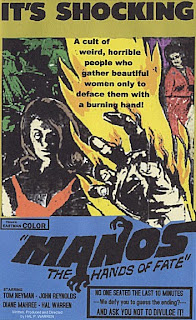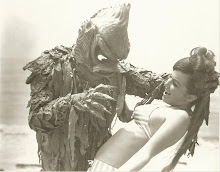We continue our countdown of the Top 100 Regional Horror Films, with a look at films 50 through 36. Feel free to chime in with your thoughts on the rankings so far, and keep watching this space as we work our way up to the Top 10 in October!
50. Tenement (New York, 1985): It's not exactly a horror film, but Tenement does
aptly convey the claustrophobic, siege mentality of Night of the Living Dead
(and Assault on Precinct 13). This was
one of the first non-porn films Roberta Findlay made and it may very well be
her best; it's certainly far more suspenseful than any of the straight horror
outings she made with producer and business partner Walter Sear.
-->
49. The Orphan (New Jersey, 1979): Saddled with a misleading alternate title (Friday
the 13th: The Orphan), this low-key tale of an orphaned child, his
overly strict aunt, and his stuffed monkey shrine, builds slowly as its young
protagonist loses his grip on reality. Shot over a period of ten years, the
film has a disjointed, weird vibe that is certainly unsettling (if not
necessarily frightening). Theme song by Janis Ian.
48. Screams of a Winter Night (Louisiana, 1979): Although it had just a brief theatrical run, and the
video has been out of print for years, this low-budget anthology has still managed
to build a small cult following over the past 30 years. The wraparound segments
are better than the individual stories, but it maintains a nice, eerie vibe
throughout.
47. Children Shouldn't Play with Dead Things (Florida,
1972): Director/actor/screenwriter/make-up
artist Alan Ormsby delivers a warped horror comedy about a troupe of obnoxious
actors who inadvertently raise the pasty-faced dead while performing mock black
magic ceremonies on a burial island at the behest of their prissy, tyrannical
director (Ormsby himself). Although not as scary or funny as it ought to be, it
was a harbinger of the varying directions the living dead would shamble over
the next two decades. And Orville the Corpse remains one of my top five
favorite zombie performances of all time.
46. The Boogens (Utah, 1982): The title is silly, and the monsters are sillier, but The Boogens
is a well-constructed, straightforward monster movie that makes effective use
of its remote, snowy mining town locations. And since the monsters did look
kind of stupid, director James L. Conway wisely leaves them offscreen most of
the time, which ups the suspense and helps lift this no-frills creature feature
above many of its low-budget contemporaries.
45. I Drink Your Blood (New York, 1970): One half of what may have been the most notorious
double feature in exploitation film history, I Drink Your Blood
actually delivers on most of its ballyhooed promises (unlike its co-feature, I
Eat Your Skin, which was actually a
bloodless, black-and-white zombie film from Del Tenney). It's thoroughly
off-the-rails plot—rabies-infected meat pies turn hippies and hard-hats alike
into slobbering, hydrophobic homicidal maniacs—lays some of the groundwork for
the zombies-as-infected-people tropes of recent decades, while still
positioning the film as a unique piece of bug-eyed lunacy.
44. Slime City (New York, 1988): Energetic, funny romp from the "wet"
period of gory, independent New York filmmaking about a man transformed into a
murderous slime monster via an addiction to "Himalayan Yogurt."
43. Brain Damage (New York, 1988): Although Frank Henenlotter's first film, Basket
Case, tends to get all the accolades, I've always been partial to
his follow up feature. A snarky, talking, phallic parasitic slug takes over the
life of his host (Rick Hearst) as he searches for more brains to eat. Featuring
the voice of horror host John Zacherle and some of the strangest imagery in any
of Henenlotter film.
42. Don't Look in the Basement (Texas, 1973): S.F. Brownrigg may not have been
the most successful regional horror director, or the most well known, but he
may very well have the most distinctive visual style in the entire genre
(unless you count H.G. Lewis' approach, which was more an anti-style). This is
probably his backwoods masterpiece, and features appropriately keyed up
performances from his familiar repertory players (Bill McGhee, Camilla Carr,
Annabelle Weenick, Gene Ross), and a gritty, sweaty ambience that you can
almost smell.
41. Two Thousand Maniacs! (Florida, 1964): Blood Feast was the first, and Wizard of Gore was
the most structurally ambitious, but I've always felt this was H.G. Lewis' most
watchable film. This gore-drenched version of Brigadoon not only boasts an
awesome bluegrass theme song (performed by Lewis himself), but also a
relatively fast-paced plot and decent acting (minor miracles in a Lewis
project).
40. Psycho From Texas (Arkansas, 1974): The psycho may have been from Texas, but the film
and its director Jim Feazell hail from El Dorado, Arkansas. With its botched
kidnapping plot and murderous, poorly-coifed lead psycho, I'm not sure this
wasn't the inspiration for both Fargo and No Country for Old
Men. Think about it.
39. Manos: The Hands of Fate (Texas, 1966): Allegedly made on a bet placed between insurance
salesman Hal Warren and screenwriter Sterling Silliphant, Manos as emerged as a
cult film whose reputation may very well have surpassed that of Plan 9 From
Outer Space and other "worst film" candidates. Nothing
else quite touches the level of tedious delirium you experience watching Manos; it defies so many cinematic conventions it's almost
not a film at all. Genius or madness?
38. The Carrier (Michigan, 1988): There's nothing I like more than a low-budget horror
film that displays some narrative ambition. That's exactly what you get with
this oddball AIDS allegory that inventively combines monsters, disease,
trashbags, and cat hoarding.
37. The Boogeyman (Maryland, 1980): Before he slid into the direct-to-video ghetto,
director Ulli Lommel made this impressive supernatural slasher flick about an
evil spirit released from the shards of a broken mirror. When I despair at the
umpteenth serial killer film in Lommel's prolific body of work (he's directed
55 films!), I always think fondly back to this one, which was financed by
Lommel's wife/leading lady/DuPont heiress Suzanna Love.
36. The Werewolf of Washington (New York/Washington,
D.C., 1973): This film has gotten a bad
rap, primarily because of its title and its wide availability as a murky public
domain item. But if you give it a chance, you'll find it contains a very good
performance from Dean Stockwell, some great bits of comedy, and some biting
political satire, much of which still holds up. I was even more impressed with
it once I learned that it had been written and filmed BEFORE the details of the
Watergate scandal were made public.













No comments:
Post a Comment